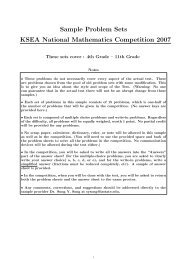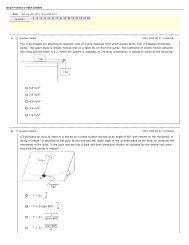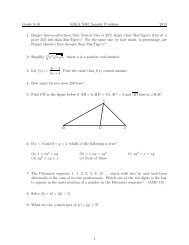Download KSEA Letters 40-3, Apr. 2012 [pdf] - Korean-American ...
Download KSEA Letters 40-3, Apr. 2012 [pdf] - Korean-American ...
Download KSEA Letters 40-3, Apr. 2012 [pdf] - Korean-American ...
Create successful ePaper yourself
Turn your PDF publications into a flip-book with our unique Google optimized e-Paper software.
FEATURED ARTICLES<br />
NANO-BIO INTERFACING: LEVERAGING ADVANCES IN SEMICONDUCTOR TECHNOLOGY FOR<br />
BIOLOGICAL RESEARCH<br />
[Hongkun Park]<br />
Professor, Chemistry and Chemical Biology and Physics<br />
Harvard University<br />
Silicon integrated circuits represent an enormously successful paradigm for electronics – they are mass-produced at low cost in silicon<br />
foundries, and yet a chip with a footprint less than a square inch, is a highly integrated superstructure that contains hundreds of millions<br />
of transistors and can process data at gigahertz rates. Moreover, they contain top-down fabricated nanostructures whose sizes are<br />
comparable to important biological molecules and cells. As such, silicon nanostructures and integrated circuits have the potential to<br />
become a unique tool for interrogating living cells and organisms when a proper interface is developed.<br />
Over the past five years, a part of my group at Harvard has been working toward developing nano-bio interfaces that maximally utilize<br />
the advantages offered by these silicon nanostructures. 1-4 Our efforts have been centered on one particular structure: vertical silicon<br />
nanowire (SiNW) arrays. These nanoscale needles, which can be fabricated en masse using standard silicon processing technology,<br />
penetrate through the cellular membrane without compromising cell viability or function, thus providing direct intracellular access to<br />
a living cell. This unique capability, which is difficult to realize by any other means, provides an exciting opportunity for many branches<br />
of biological research. In my laboratory, we have been employing these nanoscale needles (1) to investigate the intracellular circuits<br />
that are responsible for the functions of immune cells, cancer cells, and stem cells by delivering various biological effectors 1-3 and (2) to<br />
monitor and control activities of brain cells in complex neuronal networks and tissues. 4<br />
SiNW nanoinjection for cell circuit perturbation: Efficient delivery of active biological effectors (DNAs, RNAs, peptides, proteins, or<br />
small molecules) into living cells is central to biological research and pharmaceutical screening. For instance, achieving a mechanistic<br />
understanding of intracellular molecular circuits requires systematic perturbation of circuit components and analysis of the resulting<br />
changes in cellular behavior. The success of this strategy depends critically on delivering various biological perturbants into living cells<br />
without compromising their viability or function.<br />
Because many biological effectors do not spontaneously cross the plasma membrane, a host of methods have been developed to deliver<br />
them into cells. Unfortunately, in a variety of primary cells, especially in resting immune cells, many of these techniques have proven<br />
ineffective, inducing non-specific inflammation or cell death. These limitations have severely restricted the use of perturbations in<br />
uncovering the ways in which these cells respond to extra- and intracellular signals, and have been a major obstacle to elucidating the<br />
molecular biology that underlies many hematological cancers. Clearly,<br />
the resistance of these cells to conventional means necessitates the development<br />
of new approaches.<br />
6<br />
Over the past few years, we have developed a new SiNW-based nanoinjection<br />
method that can serve as a minimally invasive and efficient<br />
method for delivering a variety of biomolecules into hard-to-transfect<br />
cells. 1-3 Specifically, we showed that the surface-coated SiNWs could efficiently<br />
administer active biomolecules directly into the cytoplasm of<br />
virtually any type of cell without impacting its viability or function (Figure<br />
1). 1 We then used the method to discover new components of the<br />
Toll-Like Receptor (TLR) network in mouse dendritic cells. 2 We also<br />
applied the method to investigate patient heterogeneity in chronic lymphocytic<br />
leukemia (CLL), the most common adult leukemia in North<br />
America. 3 By perturbing CLL cells using SiNW-mediated siRNA delivery,<br />
we identified three patient response groups, unclassifiable by known<br />
criteria, that required distinctly different clinical treatment schedules.<br />
These examples show that SiNWs can contribute greatly in cell circuit<br />
studies of otherwise hard-to-transfect cells: starting from the cells taken<br />
from a single blood draw, multiple different knockdowns could be used<br />
to simultaneously probe the importance of multiple potential pathways,<br />
enabling a detailed understanding of the intracellular circuitry critical<br />
for cell function and also the development of patient-specific combinatorial<br />
therapies.<br />
Figure 1. SiNW nanoinjection. Upper Image: a confocal image<br />
of a mouse dendritic cell on top of vertical SiNWs. Magenta: cell<br />
membrane, blue: cell nucleus, whilte: SiNW. Lower diagram: a<br />
model of the Polo-like-kinase-dependent pathway of the antiviral<br />
response in mouse dendritic cells.<br />
<strong>KSEA</strong> LETTERS Vol. <strong>40</strong> No. 3 <strong>Apr</strong>il <strong>2012</strong>


![Download KSEA Letters 40-3, Apr. 2012 [pdf] - Korean-American ...](https://img.yumpu.com/23972233/8/500x640/download-ksea-letters-40-3-apr-2012-pdf-korean-american-.jpg)
![Download KSEA Letters 40-2, Jan. 2012 [pdf] - Korean-American ...](https://img.yumpu.com/23972281/1/190x245/download-ksea-letters-40-2-jan-2012-pdf-korean-american-.jpg?quality=85)









![Download KSEA Letters 40-4, Jun. 2012 [pdf] - Korean-American ...](https://img.yumpu.com/23972210/1/190x245/download-ksea-letters-40-4-jun-2012-pdf-korean-american-.jpg?quality=85)


